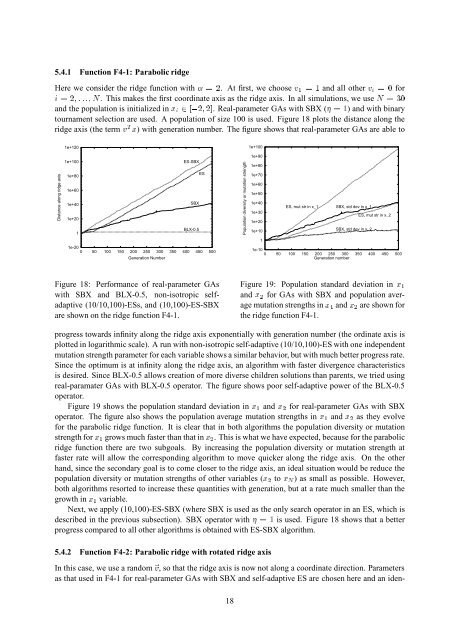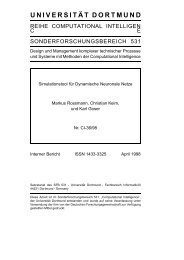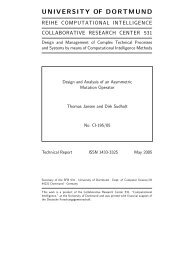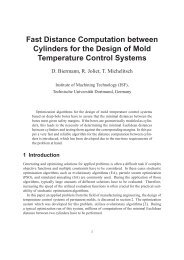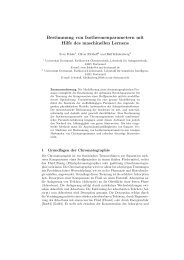Self-Adaptive Genetic Algorithms with Simulated Binary Crossover
Self-Adaptive Genetic Algorithms with Simulated Binary Crossover
Self-Adaptive Genetic Algorithms with Simulated Binary Crossover
Create successful ePaper yourself
Turn your PDF publications into a flip-book with our unique Google optimized e-Paper software.
useN=30<br />
5.4.1 Function F4-1: Parabolic ridge<br />
Here we consider the ridge function <strong>with</strong>=2. At first, we choosev1=1and all othervi=0for i=2;:::;N. This makes the first coordinate axis as the ridge axis. In all simulations, we<br />
and the population is initialized inxi2[?2;2]. Real-parameter GAs <strong>with</strong> SBX (=1) and <strong>with</strong> binary<br />
tournament selection are used. A population of size 100 is used. Figure 18 plots the distance along the<br />
ridge axis (the termvTx) <strong>with</strong> generation number. The figure shows that real-parameter GAs are able to<br />
1e+120<br />
1e+100<br />
ES-SBX<br />
ES<br />
1e+80<br />
1e+60<br />
1e+40<br />
SBX<br />
1e+20<br />
BLX-0.5<br />
1<br />
1e-20<br />
0 50 100 150 200 250 300 350 400 450 500<br />
Generation Number<br />
Figure 18: Performance of real-parameter GAs<br />
<strong>with</strong> SBX and BLX-0.5, non-isotropic selfadaptive<br />
(10/10,100)-ESs, and (10,100)-ES-SBX<br />
inx1<br />
1e+100<br />
1e+90<br />
1e+80<br />
1e+70<br />
1e+60<br />
1e+50<br />
1e+40<br />
ES, mut str in x_1 SBX, std dev in x_1<br />
1e+30<br />
ES, mut str in x_2<br />
1e+20<br />
1e+10<br />
SBX, std dev in x_2<br />
1<br />
1e-10<br />
0 50 100 150 200 250 300 350 400 450 500<br />
Generation number<br />
Figure 19: Population standard deviation<br />
andx2for GAs <strong>with</strong> SBX and population average<br />
mutation strengths inx1andx2are shown for<br />
are shown on the ridge function F4-1.<br />
the ridge function F4-1.<br />
Distance along ridge axis<br />
progress towards infinity along the ridge axis exponentially <strong>with</strong> generation number (the ordinate axis is<br />
plotted in logarithmic scale). A run <strong>with</strong> non-isotropic self-adaptive (10/10,100)-ES <strong>with</strong> one independent<br />
mutation strength parameter for each variable shows a similar behavior, but <strong>with</strong> much better progress rate.<br />
Since the optimum is at infinity along the ridge axis, an algorithm <strong>with</strong> faster divergence characteristics<br />
is desired. Since BLX-0.5 allows creation of more diverse children solutions than parents, we tried using<br />
real-paramater GAs <strong>with</strong> BLX-0.5 operator. The figure shows poor self-adaptive power of the BLX-0.5<br />
operator.<br />
Figure 19 shows the population standard deviation inx1andx2for real-parameter GAs <strong>with</strong> SBX<br />
operator. The figure also shows the population average mutation strengths inx1andx2as they evolve<br />
for the parabolic ridge function. It is clear that in both algorithms the population diversity or mutation<br />
strength forx1grows much faster than that inx2. This is what we have expected, because for the parabolic<br />
ridge function there are two subgoals. By increasing the population diversity or mutation strength at<br />
faster rate will allow the corresponding algorithm to move quicker along the ridge axis. On the other<br />
hand, since the secondary goal is to come closer to the ridge axis, an ideal situation would be reduce the<br />
population diversity or mutation strengths of other variables (x2toxN) small as possible. However,<br />
both algorithms resorted to increase these quantities <strong>with</strong> generation, but at a rate much smaller than the<br />
growth inx1variable.<br />
Population diversity or mutation strength<br />
as<br />
Next, we apply (10,100)-ES-SBX (where SBX is used as the only search operator in an ES, which is<br />
described in the previous subsection). SBX operator <strong>with</strong>=1is used. Figure 18 shows that a better<br />
progress compared to all other algorithms is obtained <strong>with</strong> ES-SBX algorithm.<br />
5.4.2 Function F4-2: Parabolic ridge <strong>with</strong> rotated ridge axis<br />
In this case, we use a random~v, so that the ridge axis is now not along a coordinate direction. Parameters<br />
as that used in F4-1 for real-parameter GAs <strong>with</strong> SBX and self-adaptive ES are chosen here and an iden-<br />
18


